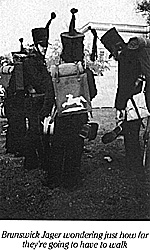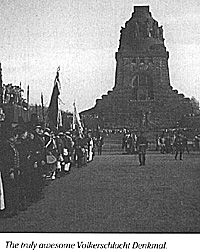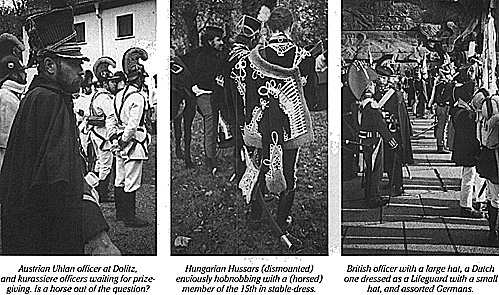 The 180th anniversary of die Volkerschlact, or the Battle of the Nations, hosted by the Napoleonische GeselIschaft at Leipzig in October 1993 provided a useful opportunity to observe the current condition and practice of European re-enactment, at a time of the year when most British re-enactors are traditionally deep in hibernation.
The 180th anniversary of die Volkerschlact, or the Battle of the Nations, hosted by the Napoleonische GeselIschaft at Leipzig in October 1993 provided a useful opportunity to observe the current condition and practice of European re-enactment, at a time of the year when most British re-enactors are traditionally deep in hibernation.
Arriving in Markkleeberg, a sizeable village cum dormitory suburb to the south of Leipzig, long after dark and honest volk's bedtimes brought a problem which is only too familiar to all re-enactors - how to find the campsite with inadequate instructions and no visible signposting. Happily the site was in the local municipal park, otherwise directions might have been a problem, but then, having found it, a rather less familiar difficulty arose.
Nocturnal arrivals at a British guardtent can usually expect to be greeted by two or three cheerful (and not always sober) individuals, eager to sign them in, distribute rubbish bags, information sheets, gratuitous insults and more or less reliable advice as to the general location of their regiment's tents.
Leipzig, however, was quite different. The large iron gates of the 'agra-Park' were firmly locked, while inside a lone sentry slowly paced up and down with shouldered firelock and fixed bayonet. The large shako was a reassuring sign that it was indeed the right place, even if his jeans and trainers didn't quite go with the rest of his martial ensemble. Despite the bayonet he turned out to be friendly enough and although his English was worse than my BAOR German he eventually indicated an alternative entrance to a rather different campsite from the ones which British reenactors are accustomed to.
Re-enactment in Britain began with the Sealed Knot in 1968 and has thereafter evolved along its own very distinctive lines, largely independent of American influences. Continental re-enactors, on the other hand, appear to be very much more inspired by transatlantic practice, and this was immediately evident in the style and arrangement of the campsite.
Regrettably 'Living History' has tended to be something of a minority interest amongst British re-enactors (with some notable exceptions of course) and although its popularity is at last growing, the larger part of British campsites is still given over to 'plastic' or modern tentage, while the 'authenties' are discreetly bundled off to one side. The reverse is true on the continent. At Leipzig the main campsite was made up of neat regimental streets of canvas tentage, while those unwilling or unable to face the rigours of camping in the pleasant, but cold, grounds of an elegant country house, were banished to a disused tank hanger on an adjacent site which had clearly been a barracks until recent political developments.
In actual fact there soon turned out to be -not one, but three quite separate bivouac areas, including one tenanted by the 'Austrians' around the manor gatehouse at Dolitz, stormed by Merveldt's Austrians during the original battle. (incidentally the relative positions of Dolitz and Markkleeberg on the maps in the recent Osprey title on the battle don't look quite right) Once again these other sites were of the 'authentic' variety and although none of the three sites were ever completely cleansed of farb, it is interesting that the continentals have readily accepted such bivouacs as the norm and indeed as a natural and integral part of reenactment, rather than as the bolt-on extra which they seem to be in Britain.
The quality and character of the various units participating in the event varied enormously, and to a certain extent practice followed national lines. Some units were very good indeed, while others were decidedly farby and there were some quite unexplained intrusions by odd figures from late 19th century armies.
Generally speaking, units from western Europe appear to be of a much higher standard than those from the former Eastern bloc, though once again there were notable exceptions such as some very elegant Hungarian hussars, some equally smart Lithuanians and a work manlike battalion of 'Austrians' from whatever Czechoslovakia has turned itself into these days.
In part this can be attributed to the head start and the American input enjoyed by the western units, and conversely to the economic and cultural problems facing reenactors east of the old NATO front line. Indeed some of the problems with the East German units appear to reflect a little uncertainty as to exactly what they're doing and why. In the west, re-enactment is simply a recreational activity, but in the east it sometimes seems to be used as a means of expressing cultural identity. There is a distinct air of 'Volk und Vaterland', celebrating sturdy German farm folk, particularly in the Landwehr/Volunteer units and authentic impressions sometimes take second place. One unit from Jena claims to portray French Cuirassiers, but while they have neither horses nor cuirasses, they do have very distinctive German style peaked caps and at least one feldgrau clad band looked as though it would have been much happier celebrating 1913 rather than 18 13.
With the exception of a lone (dismounted) dragoon of the Jena period who would have won any 'ridiculous hat' competition hands down, the majority of German units tend to go for the War of Liberation period, representing either Prussian regulars, or a variety of Landwehr/volunteer units. There are in addition KGL light infantry from Hanover and Black Brunswickers, but the latter at least are substantially made up of American servicemen with a decidedly disconcerting tendency to utter highpitched Rebel yells after firing volleys.
 Volkerschlacht Denkmal
Volkerschlacht Denkmal
The Westfalische Landwehr, as their title suggests are recruited in what was West Germany and are reasonably well equipped with firelocks and bayonets , but the Silesiche Landwehr on the other hand, from the Berlin area, are a pretty motley bunch, padding out firelocks with pitchforks, flails and other interesting implements of dubious origin. The black uniformed Lutzow Freikorps are equipped in similarly exotic fashion, though unlike the Silesians I don't recall any of them going barefoot - now there's dedication for you.
The local Saxons, on the other hand, forming a red-coated Guard Grenadier Regiment and a couple of white coated line units, are quite unrepentantly recreating the Saxon Army of the period when it was allied to the Corsican Bandit - they even rejected out of hand suggestions that they should follow historical precedent by changing sides halfway through the reenactment. There being no accounting for taste, it is possible that they actually like the idea of working for Napoleon, but it seems rather more likely that this simply reflects an independent spirit vocally expressed by one who was heard to mutter "f-- the Prussians" (well at least that's what it sounded like he said).
Very few native French units turned up -- apparently they had something else on that weekend and anyway who wants to travel a thousand miles or so to take part in one of the Emperor's less than glorious moments. The gap, however was filled by the aforementioned Saxons, Lithuanians and the usual collection of Francophiles from other countries, most notably the excellent 'National Volunteers'; a very good impression of a Revolutionary period unit, made up of Germans, Swiss and perhaps even a few genuine Frenchmen. It was commented, incidentally, that one of the curiosities of Napoleonic re-enactment is that while every participating country has raised at least one 'French' unit in addition to 'national corps', (including the Ukrainians) the French muster only French units. Chauvinist? Perish the thought ...
The British units, it has to be said, did not exactly shine and with the exception of Neil Leonard's I 5th Hussars, the quality of the impression on display was probably on a par with the former Easter bloc units. A pity, really, because some British units which weren't there, most notably the 68th Foot, will stand comparison with the very best of American practice. Indeed, that seemed to be the problem really, and in conclusion it seems clear that the divide between the good units and the others, actually lies between those units influenced by American practice and those which muddle along in their own way.
As for the event itself, given the comparatively short time in which the Napoleonische GeselIschaft has been up and running, the organisation wasn't too bad, although the lack of a proper command structure above regimental level was keenly felt on both sides. The battle on the Saturday involved a substantial hike from Markkleeberg, through Dolitz to Wachau, with a fairly substantial set-to on a field which didn't look to have changed since the last time Napoleonic soldiers tramped over it, and buses were provided to take us back afterwards. The evening was spent in traditional German style with a huge meat buffet and considerable quantities of good German beer - the food and the first couple of steins being provided gratis.
Sunday was much more relaxed, with a chance to browse through a surprisingly well-stocked sutler's row. Perhaps its the greater numbers, but this was far superior to anything I've seen at a Napoleonic event in Britain. The battle was much less atmospheric than the previous day however with a skirmish approach down the agra-Park road from Dolitz to the event proper on a very municipal bit of flat parkland (Sommerblumenweissel. The autobahn flyover from Leipzig to Gera-Chemnitz didn't do a lot of good for the backdrop either.
On the whole, it would be fair to say that European re-enactment is impressive and worth supporting. I do, however, have distinct reservations about the total lack of crowd barriers which results in camera-wielding members of the public popping up in all sorts of disconcerting and dangerous places.
Such is life, roll on Austerlitz in 1995.

Back to Napoleonic Notes and Queries #13 Table of Contents
Back to Age of Napoleon List of Issues
Back to MagWeb Master List of Magazines
© Copyright 1993 by Partizan Press.
This article appears in MagWeb (Magazine Web) on the Internet World Wide Web.
Other military history articles and gaming articles are available at http://www.magweb.com